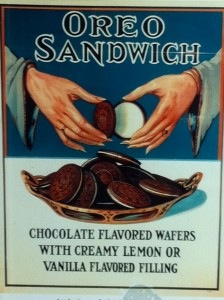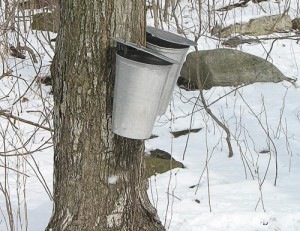Oh, Oreos! We must love them because we eat 20.5 million of them a day.
Over 491 billion Oreo cookies have been sold since they were first introduced on April 2,1912, making them the best selling cookie of the 20th century.
They were first baked at the National Biscuit Company (Nabisco) factory, which dates from the 1890’s, that runs from 15th to 16th Street between Ninth and Tenth Avenues in New York City. Now called Chelsea Market, it is a bustling office and food complex. This photo is of an Oreo label that is showcased in the main lobby.
The Original Oreo
Nabisco’s new idea for a cookie was two chocolate disks with a creme filling in between. Early Oreos looked a lot like today’s Oreo with just a slight difference in the design on the chocolate disks.
Originally they came with either a lemon or vanilla creme filling. In the US they cost 25 cents a pound and were sold in cans with glass tops so customers could see the cookies. The vanilla creme filling was more popular and production of the lemon filling was discontinued in the 1920s.
Today they come with a whole bunch of different fillings like mint, chocolate, caramel; double stuffs; chocolate coatings; and colored holiday fillings.
Oreos weren’t the first sandwich type cookies on the market. Sunshine introduced Hydrox in 1910 two full years before Oreo’s debut. But it seems that Sunshine fell short in its marketing because Hydrox never became as popular as Oreo and production stopped in the mid 1990s.
Oreos: An Interactive Food
One of the keys to Oreo’s success is its interactivity. Think about it – you don’t just eat it — you can dunk it, bite it, or twist it apart. Oreo lovers, psychologists, and food writers have all speculated about whether the way someone eats their Oreo indicates a personality type.
According to a History.com video, in 2004, Kraft (Nabisco is now a Kraft brand), surveyed over 2000 Oreo eaters and found that they are divided into three categories:
- Dunkers tend to be energetic, adventurous, and extremely social. 87% of dunkers say milk is their liquid of choice for dunking.
- Twisters — and who hasn’t twisted an Oreo – (I personally think it makes the Oreo last longer ‘cause you get two cookies) – tend to be emotional, sensitive, artistic, and trendy.
- Biters are easy going, self-confident, and optimistic.
The survey also discovered that more women tend to be dunkers while men tend to be biters. And, Democrats tend to twist, Republicans tend to dunk!
Some Stats
A serving of regular Oreos, 34 grams, has 160 calories, 7g of fat (2 saturated), 25g carbs, 1g protein,1g fiber, and160mg sodium.
According to the Nabisco label, there are about 15 servings in an 18 oz. bag. After checking lots of sites, the general consensus is that there are around 3 cookies in a 34 gram serving. It sure would be nice if Nabisco would give us the stats per cookie rather than for 34 grams so the consumer could have more useable information!




